
|
It brightened up to 4.7 mag in early May (May 2, Marco Goiato). However, the brightness evolution has stopped after that. Now it is 5.8 mag (May 12, Marco Goiato). It will approach to Sun down to 0.43 a.u. on May 27, and it was expected to brighten up to 3.5 mag. But actually it will be fading after this. In the Northern Hemisphere, it locates extremely low until early June. In the Southern Hemisphere, it is not observable after this until August.
Date(TT) R.A. (2000) Decl. Delta r Elong. m1 Best Time(A, h)
May 16 2 5.10 29 9.4 0.579 0.523 22 5.8 5:20 (239, -7)
May 23 3 39.98 44 2.4 0.748 0.446 23 6.4 5:24 (233,-25)
|
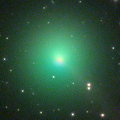
|
Now it is very bright as 8.0 mag (May 14, Chris Wyatt). Brightening very rapidly. It will approach to Sun down to 0.9 a.u. in June, and it is extected to brighten up to 5.5 mag. In the Southern Hemisphere, it stays observable in good condition for a long time after this. In the Northern Hemisphere, it is not observable until late June.
Date(TT) R.A. (2000) Decl. Delta r Elong. m1 Best Time(A, h)
May 16 5 56.36 -21 31.5 1.323 1.092 53 7.9 18:32 ( 86, 34)
May 23 6 23.12 -20 53.0 1.214 1.031 54 7.2 18:28 ( 87, 34)
|

|
Now it is 8.3 mag (May 15, Charles S. Morris). It stays bright as 8-9 mag until July. It is observable in good condition in the Northern Hemisphere. In the Southern Hemisphere, it is not observable until late June.
Date(TT) R.A. (2000) Decl. Delta r Elong. m1 Best Time(A, h)
May 16 9 0.83 73 48.7 1.670 1.622 69 8.1 18:32 (175,-19)
May 23 9 59.33 70 29.6 1.661 1.633 70 8.1 18:28 (177,-15)
|

|
Now it is very bright as 9.7 mag (May 14, Chris Wyatt). It will approach to Sun down to 0.3 a.u. on July 3, and it is expected to brighten up to 2.5 mag. In the Southern Hemisphere, it stays observable in good condition until early June when it brightens up to 8 mag. But it will not be observable around the perihelion passage. In the Northern Hemisphere, it is not observable now. It will appear in the evening sky at 3-4 mag in mid July, then it stays observable while getting fainter.
Date(TT) R.A. (2000) Decl. Delta r Elong. m1 Best Time(A, h)
May 16 6 6.24 -12 41.4 1.626 1.238 49 9.5 18:32 ( 96, 31)
May 23 6 4.98 -7 58.3 1.623 1.102 41 9.0 18:28 ( 97, 23)
|

|
Now it is 9.5 mag (May 12, Martin Masek). The nucleus was split into some fragments in late March, and the brightness evolution stopped. It brightened up to 7.0 mag in late March ((Mar. 30, Charles S. Morris). However, it is fading now. It moves along the same orbit as C/1844 Y1 (Great Comet). It approaches to Sun down to 0.25 a.u. on May 31. It was expected to brighten up to -1 mag. But it may disappear before the perihelion passage. In the Northern Hemisphere, it is observable until mid May. In the Southern Hemisphere, it will appear in the morning sky in June. But it stays very low for a while.
Date(TT) R.A. (2000) Decl. Delta r Elong. m1 Best Time(A, h)
May 16 4 17.64 49 19.2 0.816 0.532 31 9.7 18:32 (134,-25)
May 23 3 48.92 38 44.6 0.781 0.366 18 9.8 5:24 (239,-25)
|

|
Recovered from SWAN images after 24-year blank. Now it is very bright as 10.4 mag (Apr. 28, Chris Wyatt). It stays 10-11 mag until August. In the Southern Hemisphere, it stays observable in the morning sky for a long time. In the Northern Hemisphere, it is too low to observe until July.
Date(TT) R.A. (2000) Decl. Delta r Elong. m1 Best Time(A, h)
May 16 1 5.89 5 6.0 2.029 1.384 38 10.1 5:20 (249, 19)
May 23 1 29.56 6 34.8 2.010 1.379 38 10.0 5:24 (246, 20)
|
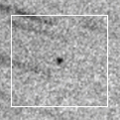
|
It will approach to Sun down to 0.34 a.u. and brighten up to 7 mag in June. In the Southern Hemisphere, it will appear in the evening sky at 7 mag in early July. Then it stays observable in good condition while the comet will be fading. In the Northern Hemisphere, it is not observable until mid August when the comet will fade down to 12 mag.
Date(TT) R.A. (2000) Decl. Delta r Elong. m1 Best Time(A, h)
May 16 3 5.91 23 9.5 1.971 0.976 7 11.7 5:20 (252,-15)
May 23 3 35.70 24 44.8 1.853 0.857 6 11.2 5:24 (250,-15)
|
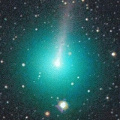
|
Now it is very bright as 9.7 mag (May 15, Charles S. Morris). It continued brightening for a while even after the perihelion passage on Mar. 15. It will be fading after this. But it may be brighter than this ephemeris. It stays observable for a long time in the Northern Hemisphere. In the Southern Hemisphere, it is not observable until June when it fades down to 13-14 mag. It seems to be a fragment of C/1988 A1 (Liller), like C/1996 Q1 (Tabur) and C/2015 F3 (SWAN).
Date(TT) R.A. (2000) Decl. Delta r Elong. m1 Best Time(A, h)
May 16 10 39.68 68 28.5 1.160 1.375 78 11.2 19:05 (180,-13)
May 23 11 9.23 59 2.2 1.233 1.467 80 12.1 19:05 (180, -3)
|
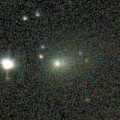
|
Now it is 12.7 mag (May 13, Martin Masek). Brightening very rapidly. It will brighten up to 8-9 mag from summer to autumn. It will be observable in excellent condition in the Southern Hemisphere. It locates very low around the high light in the Northern Hemisphere.
Date(TT) R.A. (2000) Decl. Delta r Elong. m1 Best Time(A, h)
May 16 12 44.12 -1 12.3 1.083 1.936 135 12.6 21:06 (180, 56)
May 23 12 40.69 -1 19.0 1.093 1.891 127 12.4 20:35 (180, 56)
|
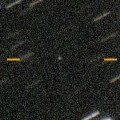
|
Now it is 17.9 mag (Apr. 20, Thomas Lehmann). It will brighten rapidly, and it is expected to brighten up to 9.5 mag in June. But actually, it has not started brightening rapidly yet. It is not observable in June. However, it stays observable in good condition until May while the comet is brightening, and after July while the comet will be fading.
Date(TT) R.A. (2000) Decl. Delta r Elong. m1 Best Time(A, h)
May 16 8 43.99 8 37.6 0.488 1.010 75 14.0 18:32 (151, 42)
May 23 8 24.34 12 19.6 0.467 0.907 63 13.2 18:28 (141, 33)
|
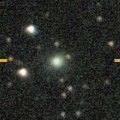
|
Now it is 14.3 mag (Apr. 22, Sandor Szabo). It will brighten up to 10.5 mag from 2020 December to 2021 January. In the Northern Hemisphere, it stays observable in good condition while the comet will be brightening gradually, but it is not observable at the high light. In the Southern Hemisphere, it is not observable for a long time, but it will be observable in good condition after the high light.
Date(TT) R.A. (2000) Decl. Delta r Elong. m1 Best Time(A, h)
May 16 13 33.03 77 58.3 2.978 2.999 81 13.6 21:50 (180,-23)
May 23 12 54.50 75 34.3 2.942 2.934 79 13.5 20:46 (180,-20)
|

|
Now it is 13.3 mag (Apr. 20, Sandor Szabo). It stays bright as 13 mag until June. In the Southern Hemisphere, it will never be observable again.
Date(TT) R.A. (2000) Decl. Delta r Elong. m1 Best Time(A, h)
May 16 1 27.39 66 31.2 4.146 3.604 51 13.8 5:20 (204,-24)
May 23 1 39.49 68 44.6 4.160 3.638 52 13.8 5:24 (201,-24)
|

|
Now it is not observable. It will appear in the morning sky in June.
Date(TT) R.A. (2000) Decl. Delta r Elong. m1 Best Time(A, h)
May 16 1 59.74 20 39.3 6.730 5.802 21 13.9 5:20 (245, -1)
May 23 2 5.17 21 11.2 6.690 5.803 26 13.9 5:24 (241, 3)
|

|
Bright new comet. Now it is 13.2 mag (Apr. 28, Alan Hale). It will fade out rapidly after this, and it will be fainter than 18 mag in late June. It stays observable in good condition in the Northern Hemisphere. It will be unobservable after this in the Southern Hemisphere.
Date(TT) R.A. (2000) Decl. Delta r Elong. m1 Best Time(A, h)
May 16 0 35.64 73 54.8 0.730 0.902 59 13.9 5:20 (195,-25)
May 23 5 43.17 79 51.9 0.879 0.958 60 14.5 18:28 (169,-31)
|
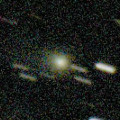
|
It brightened up to 10.8 mag (Apr. 20, Sandor Szabo). Now it is 12.9 mag (May 10, Chris Wyatt). It will fade out rapidly after this, and will be fainter than 18 mag in June.
Date(TT) R.A. (2000) Decl. Delta r Elong. m1 Best Time(A, h)
May 16 7 16.42 30 33.2 1.103 0.926 51 14.0 18:32 (143, 13)
May 23 8 7.60 29 24.3 1.153 1.028 56 14.8 18:28 (148, 17)
|

|
Now it is 14.5 mag (Apr. 22, Sandor Szabo). It stays 13-14 mag from 2020 to 2021. It stays observable in good condition for a while.
Date(TT) R.A. (2000) Decl. Delta r Elong. m1 Best Time(A, h)
May 16 12 31.71 16 23.5 2.557 3.224 123 14.2 20:53 (180, 39)
May 23 12 30.53 15 43.0 2.618 3.208 117 14.2 20:25 (180, 39)
|
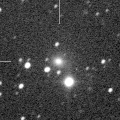
|
Now it is bright as 13.9 mag (Apr. 24, Chris Wyatt). It stays 15 mag until summer. It stays observable for a long time in the Southern Hemisphere. It is not observable until August in the Northern Hemisphere.
Date(TT) R.A. (2000) Decl. Delta r Elong. m1 Best Time(A, h)
May 16 2 49.51 -38 47.3 4.181 3.757 58 14.9 5:20 (303, 22)
May 23 2 55.28 -37 49.5 4.180 3.782 60 14.9 5:24 (299, 26)
|
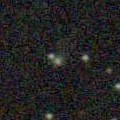
|
Now it is 15.3 mag (Apr. 25, Hiroshi Abe). It will brighten up to 13 mag in 2021. In 2020, it is observable at 15 mag in good condition from spring to summer.
Date(TT) R.A. (2000) Decl. Delta r Elong. m1 Best Time(A, h)
May 16 14 18.84 -20 38.8 4.070 5.044 162 15.1 22:40 (180, 76)
May 23 14 13.45 -20 55.8 4.067 5.004 155 15.0 22:07 (180, 76)
|
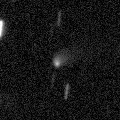
|
Now it is 15.4 mag (Apr. 22, Chris Wyatt). It stays 14-15 mag until 2021. In the Southern Hemisphere, it stays observable in good condition for a long time. In the Northern Hemisphere, it is not observable until June in 2021.
Date(TT) R.A. (2000) Decl. Delta r Elong. m1 Best Time(A, h)
May 16 16 42.91 -83 55.7 4.518 5.028 114 15.3 1:13 ( 0, 41)
May 23 16 20.13 -84 22.2 4.470 5.000 116 15.2 0:23 ( 0, 41)
|

|
Now it is 15.5 mag (Apr. 28, Katsumi Yoshimoto). It is expected to be observable at 5-6 mag for a long time from 2022 to 2023. In the Northern Hemisphere, it is not observable at the high light from 2022 summer to 2023 summer. In the Southern Hemisphere, it is only visible in the extremely low sky in summer in 2020. But it will be observable in good condition at the high light.
Date(TT) R.A. (2000) Decl. Delta r Elong. m1 Best Time(A, h)
May 16 18 4.88 52 52.2 8.915 9.159 100 15.4 2:29 (180, 2)
May 23 18 0.68 53 8.5 8.847 9.108 101 15.3 1:58 (180, 2)
|

|
Now it is 15.9 mag (Apr. 21, Catalina Sky Survey). It stays 15-16 mag for a long time until 2021.
Date(TT) R.A. (2000) Decl. Delta r Elong. m1 Best Time(A, h)
May 16 20 47.46 6 23.2 4.223 4.483 98 15.6 5:12 (180, 49)
May 23 20 43.47 7 54.9 4.113 4.480 104 15.6 4:41 (180, 47)
|

|
New comet. Now it is 16.5 mag (May 4, E. Guido, A. Valvasori). It will brighten up to 13.5 mag in spring in 2021. In the Southern Hemisphere, it stays observable in good condition for a long time. In the Northern Hemisphere, it is not observable until spring in 2021.
Date(TT) R.A. (2000) Decl. Delta r Elong. m1 Best Time(A, h)
May 16 22 42.76 -50 47.4 4.302 4.489 94 16.2 5:20 (317, 65)
May 23 22 40.26 -52 12.0 4.155 4.447 100 16.1 5:24 (328, 69)
|
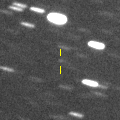
|
Now it is 17.6 mag (Mar. 22, Toshihiko Ikemura, Hirohisa Sato). It will brighten up to 15.5 mag from June to August, and it will be observable in good condition.
Date(TT) R.A. (2000) Decl. Delta r Elong. m1 Best Time(A, h)
May 16 19 17.57 -4 19.4 1.429 2.154 123 16.3 3:42 (180, 59)
May 23 19 21.41 -3 25.2 1.359 2.138 128 16.1 3:19 (180, 58)
|
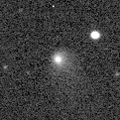
|
It brightened up to 13.8 mag in autumn in 2019 (Sept. 3, Chris Wyatt). Now it is fading slowly. It is appearing in the morning sky. In 2020, it stays observable in good condition while the comet will be fading from 16 to 17 mag.
Date(TT) R.A. (2000) Decl. Delta r Elong. m1 Best Time(A, h)
May 16 0 28.38 -4 36.7 6.133 5.553 50 16.3 5:20 (251, 32)
May 23 0 31.29 -3 54.8 6.084 5.592 56 16.3 5:24 (244, 37)
|

|
Now it is 16.2 mag (Apr. 22, D. Buczynski). It will brighten up to 12 mag in winter in 2022. In the Northern Hemisphere, it stays observable in good condition for a long time. In the Southern Hemisphere, it is not observable until 2021 November.
Date(TT) R.A. (2000) Decl. Delta r Elong. m1 Best Time(A, h)
May 16 0 9.88 49 5.2 6.869 6.269 50 16.4 5:20 (209, -5)
May 23 0 15.77 50 2.2 6.785 6.225 52 16.3 5:24 (205, -3)
|

|
It brightened up to 13.2 mag from spring to autumn in 2019 (June 30, Thomas Lehmann). Now it is fading slowly. It has already faded down to 16.0 mag (Apr. 25, iTelescope Observatory, Siding Spring). In the Southern Hemisphere, it stays observable for a long time. In the Northern Hemisphere, it is not observasble until June.
Date(TT) R.A. (2000) Decl. Delta r Elong. m1 Best Time(A, h)
May 16 0 8.09 -31 22.2 4.229 4.002 70 16.4 5:20 (279, 50)
May 23 0 10.02 -30 57.3 4.173 4.039 75 16.4 5:24 (275, 56)
|

|
It brightens up to 16 mag in May. But it is not observable in this apparition. It has been observed at three apparitions in 2003, 2012 and 2016.
Date(TT) R.A. (2000) Decl. Delta r Elong. m1 Best Time(A, h)
May 16 3 41.62 15 44.4 1.626 0.622 4 16.4 18:32 (100,-14)
May 23 4 26.90 17 16.6 1.665 0.672 7 17.3 18:28 (104,-11)
|

|
Now it is 16.7 mag (Apr. 4, M. Jaeger, E. Prosperi, S. Prosperi). It will stay at 15 mag for a long time from 2021 to 2022. In the Northern Hemisphere, it stays observable in good condition while brightening gradually. In the Southern Hemisphere, it stays locating low for a long time.
Date(TT) R.A. (2000) Decl. Delta r Elong. m1 Best Time(A, h)
May 16 18 59.43 34 10.2 6.041 6.416 107 16.5 3:24 (180, 21)
May 23 18 54.39 34 20.6 5.948 6.384 111 16.4 2:52 (180, 21)
|

|
Now it is 15.8 mag (Apr. 28, ATLAS-MLO, Mauna Loa). It is observable at 16 mag in 2020. It is observable in excellent condition in the Southern Hemisphere. It locates somewhat low in the Northern Hemisphere.
Date(TT) R.A. (2000) Decl. Delta r Elong. m1 Best Time(A, h)
May 16 19 52.17 -29 48.9 6.062 6.633 120 16.6 4:17 (180, 85)
May 23 19 46.77 -29 48.6 5.969 6.645 128 16.6 3:44 (180, 85)
|
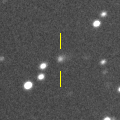
|
Now it is 16.8 mag (Apr. 28, ATLAS-MLO, Mauna Loa). It stays observable at 16-17 mag from 2020 to 2021. It locates somewhat low in the Northern Hemisphere.
Date(TT) R.A. (2000) Decl. Delta r Elong. m1 Best Time(A, h)
May 16 10 43.19 -17 48.7 6.135 6.582 112 16.6 19:05 (180, 73)
May 23 10 44.89 -17 15.2 6.228 6.582 106 16.7 18:40 (180, 72)
|

|
It brightened up to 7.7 mag in June in 2018 (June 19, Juan Jose Gonzalez). Now it is fading. It has already faded down to 16.9 mag (Apr. 22, J. Drummond). In the Southern Hemisphere, it stays observable for a long time until the comet will fade out, although it becomes extremely low in June. In the Northern Hemisphere, it is not observable until late August.
Date(TT) R.A. (2000) Decl. Delta r Elong. m1 Best Time(A, h)
May 16 5 50.28 -12 40.9 7.344 6.689 46 16.8 18:32 ( 94, 28)
May 23 5 53.69 -12 8.6 7.447 6.743 43 16.8 18:28 ( 91, 23)
|

|
Now it is 16.4 mag (Apr. 14, Katsumi Yoshimoto). It will fade out after this, and will be fainter than 18 mag in July.
Date(TT) R.A. (2000) Decl. Delta r Elong. m1 Best Time(A, h)
May 16 12 36.00 -1 43.4 1.271 2.100 133 16.9 20:58 (180, 57)
May 23 12 38.29 -1 52.4 1.327 2.102 127 17.0 20:33 (180, 57)
|

|
It brightened up to 12-13 mag from 2018 to 2019. Now it is fading. It has already faded down to 16.9 mag (Apr. 25, Blue Mountains Observatory, Leura). In the Southern Hemisphere, it stays observable in good condition for a long time. It will never be observable after this in the Northern Hemisphere.
Date(TT) R.A. (2000) Decl. Delta r Elong. m1 Best Time(A, h)
May 16 9 16.06 -66 13.3 5.078 5.442 105 16.9 18:32 ( 10, 58)
May 23 9 13.92 -64 43.6 5.158 5.488 103 17.0 18:28 ( 16, 58)
|

|
Now it is 17.1 mag (Apr. 23, D. Buczynski). It will be observable at 16.5-17 mag from spring in 2020 to summer in 2021.
Date(TT) R.A. (2000) Decl. Delta r Elong. m1 Best Time(A, h)
May 16 19 40.30 23 51.8 4.458 4.832 105 17.0 4:05 (180, 31)
May 23 19 33.29 24 3.7 4.352 4.816 111 16.9 3:31 (180, 31)
|
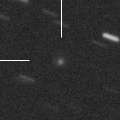
|
Now it is 16.5 mag (May 14, R. Ligustri). It will fade out after this, and will be fainter than 18 mag in July.
Date(TT) R.A. (2000) Decl. Delta r Elong. m1 Best Time(A, h)
May 16 15 25.56 4 7.1 2.593 3.544 156 17.0 23:46 (180, 51)
May 23 15 19.43 3 29.5 2.643 3.580 153 17.1 23:13 (180, 52)
|

|
Now it is 16.9 mag (Apr. 24, J. Drummond). It is expected to brighten up to 13 mag in 2022. In 2020, it is observable in excellent condition in the Southern Hemisphere. In the Northern Hemisphere, it is not observable. It will be observable from autumn to winter, but it locating extremely low.
Date(TT) R.A. (2000) Decl. Delta r Elong. m1 Best Time(A, h)
May 16 6 32.73 -26 38.7 7.675 7.278 63 17.0 18:32 ( 85, 43)
May 23 6 37.21 -26 16.8 7.683 7.237 60 17.0 18:28 ( 83, 39)
|

|
Now it is 16.8 mag (Apr. 21, ATLAS-MLO, Mauna Loa). It will be fading after this, and it will be fainter than 18 mag in late June.
Date(TT) R.A. (2000) Decl. Delta r Elong. m1 Best Time(A, h)
May 16 12 59.98 0 8.1 1.401 2.257 138 17.1 21:22 (180, 55)
May 23 13 0.24 -0 22.6 1.470 2.273 131 17.2 20:55 (180, 56)
|
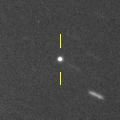
|
It brightened up to 15.9 mag in February and March (Feb. 18, Toshihiko Ikemura, Hirohisa Sato). Now it is fading. It has already faded down to 17.3 mag (Apr. 26, A. Diepvens). It will be fainter than 18 mag in late June.
Date(TT) R.A. (2000) Decl. Delta r Elong. m1 Best Time(A, h)
May 16 10 13.98 -0 55.4 1.146 1.657 100 17.2 18:37 (180, 56)
May 23 10 21.41 -4 0.1 1.214 1.666 96 17.3 18:28 (174, 59)
|
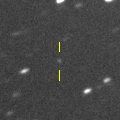
|
Now it is 17.9 mag (Apr. 25, Ken-ichi Kadota). It stays observable at 16-17 mag for a long time until 2024.
Date(TT) R.A. (2000) Decl. Delta r Elong. m1 Best Time(A, h)
May 16 16 1.52 -17 37.8 8.916 9.919 172 17.2 0:27 (180, 73)
May 23 15 57.17 -17 19.3 8.890 9.901 176 17.2 23:51 (180, 72)
|

|
Now it is 17.6 mag (Apr. 24, D. Buczynski). It will brighten up to 16.5 mag and will be observable in good condition from June to October.
Date(TT) R.A. (2000) Decl. Delta r Elong. m1 Best Time(A, h)
May 16 20 19.80 6 3.8 1.846 2.321 104 17.5 4:44 (180, 49)
May 23 20 25.12 7 44.0 1.764 2.302 108 17.4 4:22 (180, 47)
|

|
Now it is 17.2 mag (Apr. 24, J. Drummond). It will brighten up to 15.5 mag in early 2021. In 2020, it stays observable at 17 mag until November in the Southern Hemisphere, or until July in the Northern Hemisphere.
Date(TT) R.A. (2000) Decl. Delta r Elong. m1 Best Time(A, h)
May 16 14 25.05 -32 58.5 2.542 3.507 159 17.4 22:46 (180, 88)
May 23 14 18.60 -32 34.8 2.512 3.453 154 17.4 22:12 (180, 88)
|
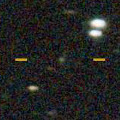
|
Now it is 17.3 mag (Apr. 24, Catalina Sky Survey). It became brighter than orignally predicted. It stays observable at 17 mag in good condition until autumn.
Date(TT) R.A. (2000) Decl. Delta r Elong. m1 Best Time(A, h)
May 16 12 39.14 -7 2.1 1.439 2.280 136 17.5 21:01 (180, 62)
May 23 12 38.25 -7 16.7 1.476 2.259 129 17.5 20:33 (180, 62)
|

|
Now it is 17.7 mag (May 14, Charles S. Morris). It will be fading slowly after this. It is observable in good condition in the Northern Hemisphere. In the Southern Hemisphere, it is observable in the extremely low sky only in 2021 spring.
Date(TT) R.A. (2000) Decl. Delta r Elong. m1 Best Time(A, h)
May 16 12 42.03 53 24.5 8.630 8.842 98 17.5 21:04 (180, 2)
May 23 12 39.99 52 42.8 8.710 8.854 94 17.5 20:34 (180, 2)
|
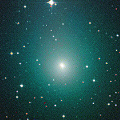
|
It brightened up to 8.3 mag in last September (Sept. 20, Maik Meyer). Now it is fading. It has already faded down to 17.1 mag (Apr. 5, iTelescope Observatory, Siding Spring). In the Southern Hemisphere, it stays observable for a long time after this. In the Northern Hemisphere, it will never be observable again.
Date(TT) R.A. (2000) Decl. Delta r Elong. m1 Best Time(A, h)
May 16 1 34.48 -64 24.8 3.435 3.522 86 17.5 5:20 (328, 40)
May 23 1 51.93 -66 23.6 3.441 3.591 90 17.6 5:24 (331, 41)
|

|
It brightens up to 13.5 mag in winter. But it is not observable at high light. In the Southern Hemisphere, it stays observable in good condition until autumn when the comet will brighten up to 14 mag. It stays locating very low in the Northern Hemisphere.
Date(TT) R.A. (2000) Decl. Delta r Elong. m1 Best Time(A, h)
May 16 19 1.41 -45 39.1 2.138 2.889 129 17.8 3:27 ( 0, 79)
May 23 18 59.96 -46 7.8 2.049 2.859 135 17.5 2:58 ( 0, 79)
|

|
Now it is 17.3 mag (Apr. 23, D. Buczynski). It will be observable at 16.5-17 mag from 2020 to 2021.
Date(TT) R.A. (2000) Decl. Delta r Elong. m1 Best Time(A, h)
May 16 1 53.11 67 18.6 6.877 6.286 50 17.6 5:20 (204,-26)
May 23 1 56.68 67 35.9 6.861 6.271 50 17.5 5:24 (203,-24)
|

|
It will pass the perihelion in 2021, and it is predicted to be observable at 17-18 mag from 2020 to 2022. However, it has not been observed at all since 2015. It was not detected, fainter than 20.5 mag, in 2017 May (Werner Hasubick).
Date(TT) R.A. (2000) Decl. Delta r Elong. m1 Best Time(A, h)
May 16 20 40.21 -21 55.3 5.663 6.061 108 17.6 5:05 (180, 77)
May 23 20 41.03 -21 52.4 5.549 6.048 115 17.5 4:38 (180, 77)
|

|
Now it is 15.3 mag (Apr. 25, Ken-ichi Kadota). It approached to Sun down to 0.5 a.u. in March, and it must have brightened up to 14 mag. It will fade out very rapidly after this.
Date(TT) R.A. (2000) Decl. Delta r Elong. m1 Best Time(A, h)
May 16 9 7.31 -4 31.9 0.823 1.255 85 17.6 18:32 (152, 57)
May 23 9 44.99 -5 21.5 0.930 1.356 88 18.2 18:28 (157, 59)
|
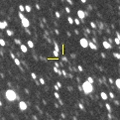
|
Now it is 18.4 mag (Apr. 22, W. Hasubick). It stays observable at 18 mag for a long time from 2019 to 2021.
Date(TT) R.A. (2000) Decl. Delta r Elong. m1 Best Time(A, h)
May 16 19 14.12 -17 12.6 7.030 7.686 127 17.7 3:39 (180, 72)
May 23 19 11.97 -17 42.9 6.942 7.688 134 17.7 3:09 (180, 73)
|
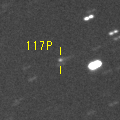
|
Now it is 17.7 mag (Apr. 14, Y. Sugiyama). It will brighten up to 13 mag in 2022. In 2020, it is observable at 17.5 mag in good condition in spring. It locates somewhat low in the Southern Hemisphere.
Date(TT) R.A. (2000) Decl. Delta r Elong. m1 Best Time(A, h)
May 16 10 11.24 20 38.9 4.243 4.397 92 17.7 18:34 (180, 34)
May 23 10 13.51 20 11.2 4.335 4.383 86 17.7 18:28 (174, 35)
|

|
Now it is 17.6 mag (Feb. 3, ATLAS-HKO, Haleakala). It brightened up to 14 mag from autumn to winter in 2018. Now it is fading. It will be fainter than 18 mag in May.
Date(TT) R.A. (2000) Decl. Delta r Elong. m1 Best Time(A, h)
May 16 12 46.03 -3 12.5 4.146 4.929 136 17.9 21:08 (180, 58)
May 23 12 43.13 -3 22.2 4.265 4.967 129 18.0 20:37 (180, 58)
|
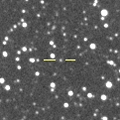
|
Now it is 17.0 mag (Apr. 26, ATLAS-MLO, Mauna Loa). It is observable at 17-18 mag in good condition in 2020 summer.
Date(TT) R.A. (2000) Decl. Delta r Elong. m1 Best Time(A, h)
May 16 19 57.60 26 35.7 8.736 8.984 101 18.0 4:22 (180, 28)
May 23 19 55.56 27 24.5 8.653 8.977 105 17.9 3:53 (180, 28)
|

|
Now it is 19.2 mag (Apr. 30, Mt. Lemmon Survey). It will brighten very rapidly, and brighten up to 14.5 mag from August to September. In the Northern Hemisphere, it stays observable for a long time, although it becomes extremely low in early September. In the Southern Hemisphere, it is observable only until mid June.
Date(TT) R.A. (2000) Decl. Delta r Elong. m1 Best Time(A, h)
May 16 22 21.00 15 46.1 1.961 1.936 73 18.3 5:20 (205, 35)
May 23 22 27.29 20 35.9 1.795 1.848 76 17.9 5:24 (197, 33)
|
|
![]()
 115P/Maury
115P/Maury C/2017 B3 ( LINEAR )
C/2017 B3 ( LINEAR ) C/2019 L3 ( ATLAS )
C/2019 L3 ( ATLAS ) C/2018 A6 ( Gibbs )
C/2018 A6 ( Gibbs ) P/2003 T12 = P/2012 A3 ( SOHO )
P/2003 T12 = P/2012 A3 ( SOHO ) C/2018 U1 ( Lemmon )
C/2018 U1 ( Lemmon ) C/2017 U7 ( PanSTARRS )
C/2017 U7 ( PanSTARRS ) C/2019 C1 ( ATLAS )
C/2019 C1 ( ATLAS ) C/2016 M1 ( PanSTARRS )
C/2016 M1 ( PanSTARRS ) 87P/Bus
87P/Bus C/2017 M4 ( ATLAS )
C/2017 M4 ( ATLAS ) C/2017 Y2 ( PanSTARRS )
C/2017 Y2 ( PanSTARRS ) P/2019 LM4 ( Palomar )
P/2019 LM4 ( Palomar ) C/2019 T4 ( ATLAS )
C/2019 T4 ( ATLAS ) P/2019 Y2 ( Fuls )
P/2019 Y2 ( Fuls ) 124P/Mrkos
124P/Mrkos C/2020 F2 ( ATLAS )
C/2020 F2 ( ATLAS ) 257P/Catalina
257P/Catalina 28P/Neujmin 1
28P/Neujmin 1 278P/McNaught
278P/McNaught C/2010 U3 ( Boattini )
C/2010 U3 ( Boattini ) C/2018 W2 ( Africano )
C/2018 W2 ( Africano ) 17P/Holmes
17P/Holmes C/2019 T3 ( ATLAS )
C/2019 T3 ( ATLAS ) C/2014 F3 ( Sheppard-Trujillo )
C/2014 F3 ( Sheppard-Trujillo ) P/2020 G1 ( Pimentel )
P/2020 G1 ( Pimentel ) C/2017 K5 ( PanSTARRS )
C/2017 K5 ( PanSTARRS ) 117P/Helin-Roman-Alu 1
117P/Helin-Roman-Alu 1 (944) Hidalgo
(944) Hidalgo A/2019 O3
A/2019 O3 C/2020 H4 ( Leonard )
C/2020 H4 ( Leonard )![]()












































